Final Dutch attainment test called into question: ‘It is time for a cultural change’
The final attainment test in primary education has been the subject of fierce debate for years. At issue are not only the content and the timing of the tests, but also the weight they are given in the final school advice. It is this last point that particularly worries test expert and TiU PhD holder Karen Heij. In her thesis, she warns that, in the Netherlands, we have gone too far in our urge to test.

In 2015, it was established by law that the school advice given by the teacher is leading in the admission of students to a secondary school. This advice is based on a number of “hard” and “soft” data of the pupil.
Hard data comes from the pupil monitoring system—a monitor that keeps track of how the pupil performs during his or her elementary school years—and consists of test results from years 6, 7, and 8. The soft data relate to factors such as social-emotional development, perseverance, and motivation.
After the advice has been issued and the children are already enrolled in their new school, it is time for the final attainment test. This takes place every year in April and is mandatory for every pupil in year 8, regardless of the type of education. The so-called test advice follows from this attainment test. Only if this is higher than the previous school advice can the final school advice still be changed in favor of the student.
So the final attainment test in its current form does count, but it is no longer as decisive as it once was. And yet, the emphasis is still too much on tests, says Karen Heij. She obtained her PhD at the end of April with the thesis Van de kat en de bel. Tellen en vertellen met de eindtoets basisonderwijs. (About belling the cat. Counting and narrating with the final elementary school attainment test)
These changes regarding the school advice aim to give the final attainment test a less decisive role in children’s educational opportunities. Isn’t that a good development?
“Labeling the final attainment test as a second opinion is just a matter of framing. At first glance, it seems like the right move, but if you zoom in further you see that the assessment based on fixed test moments continues. It only happens under a different heading: the pupil monitoring system.
“This system has been mandatory since 2011 and stores all test results from years 1 to 8. The results of the last three years must be explicitly included in the school advice. The final attainment test in itself may weigh less heavily, but the principle of ranking children based on test results remains intact.”
What’s wrong with that principle?
“It assumes that the results of a test provide an objective (and therefore fair) measurement of a pupil’s acquired knowledge and skills—and thus his or her potential. But the reality is more subtle.
“Because they are standardized tests with the same type of assignments, it makes sense, for example, to practice taking the tests. Highly educated parents are more likely to have resources to finance such extra training or a course compared to low educated parents. This results in higher scores for children of highly educated parents.
“Another point is that the tests are in fact language and math tests. This emphasis on language is often detrimental to (immigrant) children who appear at the start with a different mother tongue.
“It is known that it takes these students about seven to eight years to reach the same language level as students who have a good command of the Dutch language. However, they are not given this time and space within primary education. As a result, they remain in the lower regions in comparative tests.”
To what extent is this a problem if, in secondary education, they have the opportunity to move up to HAVO or VWO?
“It is a mistake to think that mobility within secondary education is high. Instead, it is full of partitions. The stacking of diplomas is possible on paper, but in practice, it has largely been cut over the past decade.
“For example, a HAVO program (senior general secondary education) is financially penalized if a student fails to pass the HAVO, which causes the school to demand a good grade list from the VMBO (prevocational secondary education) pupil in order to enter. After all, it wants to be sure that the future student will get the diploma.
“This kind of extra requirement discourages progression between different levels of education. Partly because of this, the education system has become a shuffleboard system in which you are put in a scoring area and then can’t get out. The problem, then, is not so much the testing itself, but the heavy consequences associated with it. It has too dominant a position in determining children’s chances.”
Why is it that measurement and testing are so central to Dutch primary education?
“Unlike other Western countries, in the 1960s, we did not change to a middle school—a kind of mixed, broad transition year system in which students stay together for three additional years before selection takes place—but were the only ones to stick with the idea of early selection based on measurements.
“One explanation seems to be that, in the Netherlands, we tend to see education as a expenditure item rather than a cultural enrichment. Therefore, we try to set up the education system as efficiently as possible. In implementation, this amounts to investing in those who are worth investing in. Those who do not fall into this category must be filtered out as quickly as possible. Tests function as an effective sieve in this regard.
Continue reading after the image

“Behind the Dutch culture of testing, there is also an economic motive. By means of selection, we ensure that the labor market gets what it needs; a good balance between the highly educated and the less educated. The current testing method is structured in such a way that twenty percent goes to VWO (pre-university education), thirty percent to HAVO and fifty percent to VMBO.
“So the tests have, as their premise, the creation of difference between children. They are designed to put students in an order, not to measure their qualities or suitability for one of the three levels. It is, therefore, nonsense to say to a child that he or she would not be a “VWO child.” Especially since there is no such thing as a VWO profile. In addition, the differences between them are often not even that great, and thus, children are wrongly told that they are stupid or not smart enough.”
How did the Netherlands come to this child-unfriendly attitude? Surely, assessment tests such as the final attainment test are designed precisely for the benefit of the child?
“That is very much the question. In the Netherlands, we once started with the final attainment test because it was the most practical way to both select children early and check the quality of schools.
“Because all schools offered the subjects of math and language—and so that was the greatest common denominator to judge schools on—the decision was made to test on those subjects. Not because they would be the best predictor of children’s futures.”
But don’t children benefit from early selection and educational inspection? That way, they will receive customized education and the quality of education is ensured.
“As mentioned before, early selection of children serves society rather than the child him/herself. In addition, worldwide research shows that every pupil benefits from mixed classes. The bottom of the class can then pull themselves up to the top. And by explaining things to fellow students, better-performing pupils advance as well.
“Unfortunately, quality inspection of schools based on test results does not benefit the development of children either. First, because education is shaped by the tests that schools are judged on. Because these mainly consist of multiple choice and arithmetic and language assignments, education and teaching methods are set up accordingly. This leads to an impoverishment of education.
“Moreover, school assessments are often corrected for the background of the students. If a school with relatively many Turkish or Moroccan children scores low during the inspection, they often still receive a positive inspection assessment. This happens because the inspection recognizes that it is a bigger task for this school to get their pupils to score high on the test.
“The problem is that, by doing this, you are perpetuating a low level of expectation for that school and those students; we actually accept that kids perform lower because they have a certain background.”
In its latest report, the Education Council recommends postponing the moment of selection until after a broad three-year transition period, thus eliminating the current school advice and the final attainment test. Is this a step in the right direction?
“The first and most important change I would like to see is that an overarching educational vision is established. Currently, the Netherlands lacks a generally formulated objective against which concrete educational policy can be measured. This is necessary for the discussion regarding the final attainment test because, in this way, one can derive the validity of the test from a broader educational direction.
“Regarding the advice of the Education Council, I have mixed feelings. It is positive that they want to select later, but at the same time they say that there must be earlier and better differentiation between students. So then you keep doing exactly the same thing as before, namely applying continuous standardized measurement.
“It takes a cultural shift where we move away from constant testing. It doesn’t contribute to a child’s development, just as a chicken doesn’t get heavier if it is weighed often. It is time to realize that we cannot predict the future based on a test. We’d be better off investing in good education than locking children into their past.”






